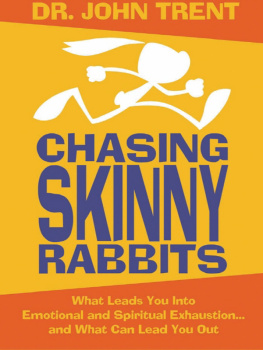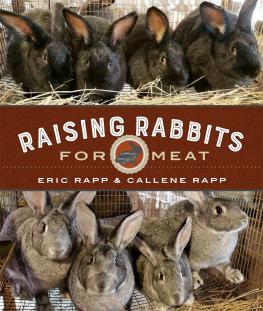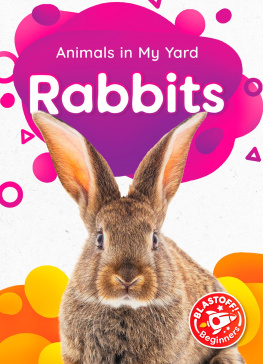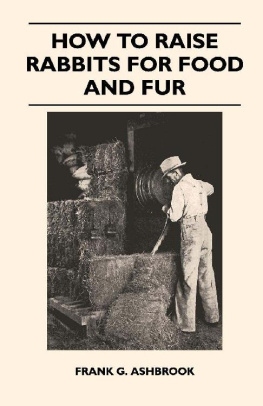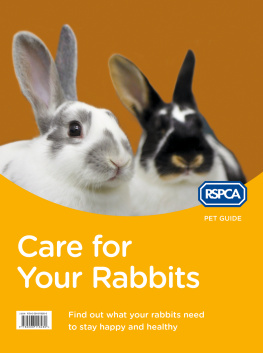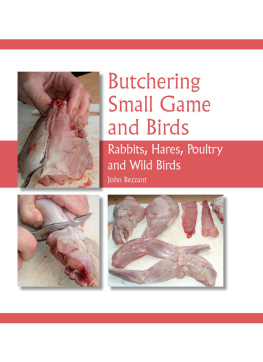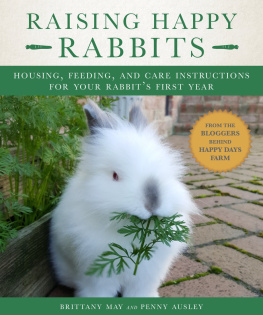Rabbits: The Animal Answer Guide
Rabbits
The Animal Answer Guide
Susan Lumpkin and John Seidensticker

2011 Susan Lumpkin and John Seidensticker
All rights reserved. Published 2011
Printed in the United States of America on acid-free paper
9 8 7 6 5 4 3 2 1
The Johns Hopkins University Press
2715 North Charles Street
Baltimore, Maryland 21218-4363
www.press.jhu.edu
Library of Congress Cataloging-in-Publication Data
Lumpkin, Susan.
Rabbits : the animal answer guide / Susan Lumpkin and John Seidensticker.
p. cm.
Includes bibliographical references and index.
ISBN-13: 978-0-8018-9788-7 (hardcover : alk. paper)
ISBN-10: 0-8018-9788-2 (hardcover : alk. paper)
ISBN-13: 978-0-8018-9789-4 (pbk. : alk. paper)
ISBN-10: 0-8018-9789-0 (pbk. : alk. paper)
1. LeporidaeMiscellanea. 2. RabbitsMiscellanea. I. Seidensticker, John.
II. Title.
QL737.L32L858 2010
599.32dc22 2010019455
A catalog record for this book is available from the British Library.
Special discounts are available for bulk purchases of this book. For more information, please contact Special Sales at 410-516-6936 or specialsales@press.jhu.edu.
The Johns Hopkins University Press uses environmentally friendly book materials, including recycled text paper that is composed of at least 30 percent post-consumer waste, whenever possible. All of our book papers are acid-free, and our jackets and covers are printed on paper with recycled content.
And suddenly the rabbit, which had been crouching as if
it were a flower, so still and soft, suddenly burst into life.
Round and round the court it went, as if shot from a gun,
round and round like a furry meteorite, in hard tense circles
D. H. LAWRENCE
Rabbits: The Animal Answer Guide
Contents
Acknowledgments
We dedicate this book to the late Robert S. Hoffmann, who taught John mammalogy, and to the late John F. Eisenberg, who taught Susan to ask interesting questions about mammals.
Many people shared their research, ideas, and time and encouraged us to write this book. We are especially grateful to Nstor Fernndez, who showed us European rabbits and Iberian lynx in Doana National Park, where our interest in rabbits began, and to Miguel Delibes, who arranged for Nestor to host us.
We also thank Lee R. Berger, Howard Cheng, Art Drauglis, John Flux, Tom Friedel, Neil Furey, Ted Grand, Haplochromis, Chris Harshaw, Jeremy Holden, Shah Jahan, Brian Kraatz, Jeff Kerby, Robert K. Lawton, John Litvaitis, Paolo Lombardo, Barney Long, Sriyanie Miththapala, Kate OBrien, Tamara Rioja Paradela, Silviu Petrovan, Michael J. Plagens, Colin Poole, Janet Rachlow, Mario Sacramento, Jason Schmidt, Walter Siegmund, Andrew Smith, Bill Tietjen, Thomas Voekler, Chris Wemmer, Gehan de Silva Wijeyeratne, Don Wilson, Jim Witham, Fumio Yamada, and the many, many lagomorph biologists whose work is cited throughout the text and in the bibliography.
Finally, we thank our daughter, Lala Seidensticker, for appreciating our enthusiasm and cheerfully tolerating us.
Introduction
A few years ago we walked through Spains Doana National Park hoping to catch a glimpse of a very rare cat. Doana is home to a few of the last Iberian lynx, a beautiful cat many experts believe will be the first felid to go extinct since the sabertooth. We were thrilled to spot one in the dusky light and even follow it for a bit as it set out on an evening hunt. A few minutes later, we were equally excited to see a European rabbit, the lynxs near-exclusive prey and one of the worlds most abundant and widespread mammals.
It is an ecological irony, that, thanks to human efforts, these rabbits now occupy most of the rest of Western Europe, Australia, parts of South America, North Africa, and more than 800 islands around the world, but they are disappearing in Iberia, their sole home for many thousands of years. This experience piqued our curiosity about European rabbits and then about their kin, the other 90 or so species of rabbits, hares, and pikas that make up the mammalian order Lagomorpha. Having spent years exploring the world of predatorscats and other carnivoresit was time to take a closer look at some of their most important prey.
Lagomorphs feed many carnivores, including many people. They also fire our imaginations. From the dawn of history, rabbits and hares have figured in stories, symbols, and myths of people around the world, with at least one species native to every continent except Australia and Antarctica. From the rabbit in the moon of Asian folklore and hare tricksters in literature from around the globe to Peter Rabbit and Bugs Bunny, rabbits have long loomed large in the human psyche, all the more so for their association with sexuality and fertility, from representing Aphrodite to their personification as Playboy bunnies.
Yet while every small child knows what a rabbit looks like, and hundreds of thousands of Americans keep rabbits as pets, few people know much about lagomorphs as wild animals living outside of cabbage patches. Fewer still know anything about the diverse forms they come in, or of their importance in ecosystems, or that several of their kind are among the most endangered species on Earth. Its difficult to convince people that rabbits are in trouble because, if nothing else, everyone knows that rabbits breed like rabbits. We hope our book will help change that misperception.
Apart from this, lagomorphs are fascinating in their own right. In this book, we discuss all aspects of the lagomorphs: what is known and what remains to be learned about the diverse species; their anatomy and physiology, evolutionary history, ecology and behavior, and conservation; and their historic and contemporary relationships with people, as both wild and domesticated animals.

Critically endangered Iberian lynx (Lynx pardina) rely on European rabbits (Oryctolagus cuniculus), which are near threatened in Iberia but abundant elsewhere. Lynx photo John Seidensticker; rabbit photo Paolo Lombardo
We hope that as readers learn about these animals they will find them as intriguing as we do and will be inspired to join efforts to conserve them.
Chapter 1
Introducing Rabbits
What are lagomorphs?
What, if anything, is a rabbit?
ALBERT F. WOOD
Rabbits and hares are lagomorphs, a word that means hare-shaped in Greek. There are few people who cant readily picture rabbits and hares. These animals are found around the world as native or introduced species and figure prominently in myths and legends, art and literature, cuisine and popular culture. Far less well known than rabbits and hares is the third group of the order Lagomorpha: the pikas. Pikas are small mammals resembling guinea pigs that reside mostly in remote mountains and deserts in parts of Asia; two kinds of pikas are found in North America. All lagomorphs are most notably prey species, with extensive adaptations for evading the many mammals and birds that hunt them.
Many people automatically think that lagomorphs are rodents, lumping them with rats, mice, and other relatively small, scurrying herbivorous creatures. For a long time, scientists shared this misperception. Linnaeus, the father of taxonomy, which is the science of classifying living things, placed both kinds of mammals in the order Rodentia. One feature he identified as uniting these two groups of mammals is gnawing incisors (front teeth) that grow continuously throughout the animals lives. But Linnaeus also recognized a key difference: Lagomorphs have two extra upper incisors, small peglike teeth that sit behind the prominent front teeth. Thus, the lagomorphs were dubbed the Duplicidentata (duplex-toothed) and the rodents the Simplicidentata (simple-toothed).
Next page

